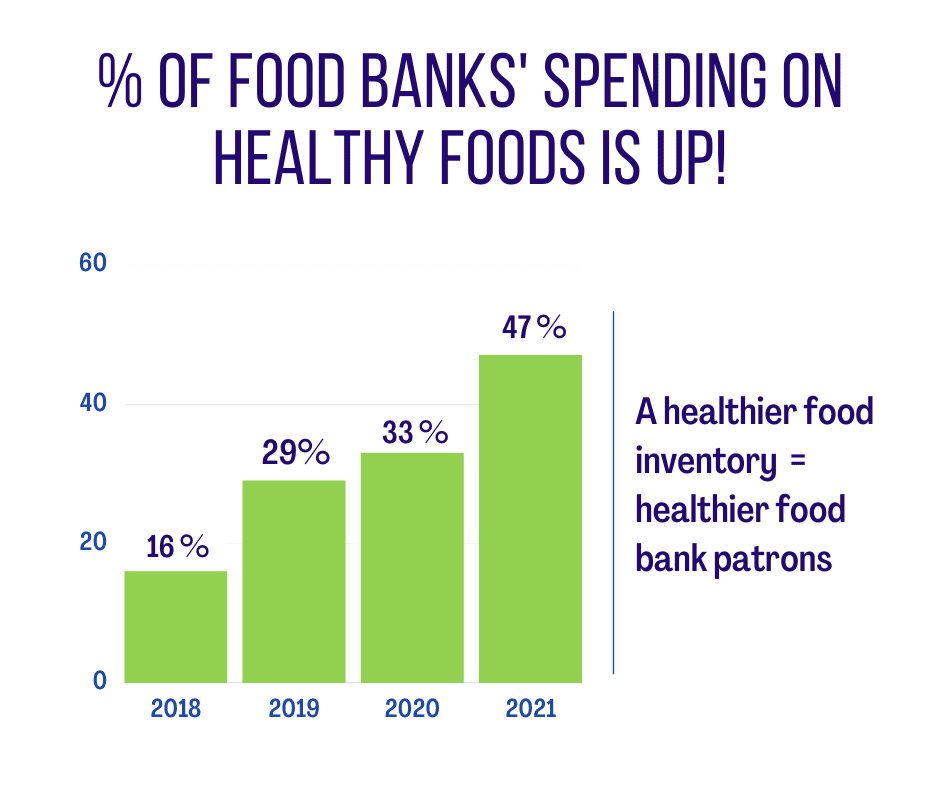Arkansas Food Banks Buying Healthier Foods with Help of Color-Coding System
The six Feeding America food banks in Arkansas are spending more of their money on healthier foods to stock their inventory, growing from 16 percent in 2018 to 47 percent in 2021 because of a simple color-coding system that categorizes foods as “choose often,” “choose sometimes” or “choose rarely” based on their nutritional value.
Jill Niemeier, former project manager with UAMS’ Office of Community Health and Research in Springdale, launched the color-coding intervention four years ago, which has spurred the upward trend in healthy food spending. She started at the top level with the State Food Purchasing Program where the six Arkansas food banks purchase much of their inventory. It’s a state-funded grant managed by the Arkansas Hunger Relief Alliance that allows the food banks to buy from Arkansas-based food distributors. Michelle Shope, director of food resourcing and logistics for Arkansas Hunger Relief Alliance who was an early partner with Niemeier, recognized the ease and benefit of using color-coding on their food order forms so food banks could quickly identify healthy options.
Color coding foods at the food bank level trickles down to their partner agencies (food pantries) and the individuals that depend on them for food. They’ll know which foods are healthier without having to interpret complicated nutrition labels. All foods are tagged with green (choose often), yellow (choose sometimes) or orange (choose rarely) depending on their saturated fat, sodium and added sugar. Even fruits and vegetables don’t get an automatic green label because some canned or frozen options have added sodium and sugar. The coding is based on the Healthy Eating Research Nutrition Guidelines for the Charitable Food System, also known as HER.

Jill Niemeier, former project manager with UAMS’ Community Health and Research in Springdale, checks an inventory list with Value Added Food Sales operations manager, Derek Mounce.
The project grew wings when Michigan-based food distributor Value-Added Food Sales entered the state in 2021. Value-Added distributes food to non-profit and other charitable food organizations across the nation. Its new warehouse in Springdale, Arkansas, allowed food banks to buy from it through the State Food Purchase Program. The food distributor has been working with the UAMS team to sort, rank and color-code its inventory, based on nutrition information for its 200-plus food items. Niemeier said the color-coded labeling could expand beyond Arkansas, benefitting any organization that purchases from Value-Added Food Sales. The company distributes to 50 states as well as Puerto Rico.
“This partnership is very exciting,” Niemeier said. “Color coding or otherwise labeling food items is a simple intervention that has the potential for great impact. Taking the burden off of food banks and other purchasing agencies to decipher nutrition labels makes it easier for them to make informed choices about the foods they are purchasing.”
Niemeier had worked alongside the UAMS Department of Family and Preventive Medicine’s State Physical Activity and Nutrition for Arkansas (SPAN) which seeks to lower obesity in Arkansas by promoting healthy eating, physical activity and breastfeeding. The program is funded by the Centers for Disease Control and Prevention with the goal to reduce obesity and the chronic illnesses that come with it, namely diabetes.
It’s especially important that those who are food insecure have healthy options since diabetes is more prevalent in this group. Ten percent of Americans have diabetes and a third have prediabetes, but for those who are food insecure, diabetes is twice as common, according to healthaffairs.org. Food insecurity can worsen diabetes in many ways including less access to nutritious foods, higher distress related to diabetes management, and difficult trade-offs such as choosing between food and medications.
“I believe these kinds of nutrition interventions are meaningful because diet-related diseases are more common among individuals who are food insecure, and it requires both a top-down and bottom-up approach to help mitigate that,” Niemeier said. “I hope projects like these will continue across the charitable food system so individuals will have access to healthy foods for themselves and their families.”
